If you want to know about the Egyptian architecture or roman architecture or gothic architecture, please click the link.
Early Christian architecture refers to the architectural style and designs used in the construction of religious buildings during the early Christian era, between the 4th and 6th centuries. This architectural style was influenced by the Roman and Greek styles, but also incorporated elements of the local cultures in the areas where early Christianity spread.
- WHAT is Christianity: Christianity is a religion based on the person and teachings of Jesus Christ, or its beliefs and practices. Had its birth in Judaea, an eastern province of the roman empire, spread and carried by St. Peter, St. Paul and other missionaries to Rome.
- WHAT is Early Christian Architecture: “Early Christian Architecture” refers to the architecture of the early Christian Churches.
- Early Christian Architecture created for the Christian Church in approximately the first 600 years after the time of Christ particularly in Italy and the western Mediterranean area.
- This period from 300 AD t0 750 AD was significant for the development of Byzantine art and architecture.
- Emperor Constantine the Great made Christianity one of the official religions of the Roman Empire, thereby putting an end to the persecution/ ill-treatment of the Christians,
- Christian art was restricted to the decoration of the hidden places of Christian worship, such as catacombs and titular, private houses used for secret religious meetings.
- Most early Christian art in the form of painting and sculpture was derived from Roman art, appropriately adapted to suit the spiritual nature of the religion.

- Early Christian architecture may be taken to have lasted from about 300 to 600 AD.
- The Early Christians, as Roman craftsmen, continued old Roman traditions
- Utilized as far as possible the materials from Roman temples which had become useless for their original purpose for their new buildings.
- Their churches, modeled on Roman basilicas, used old columns which by various devices were brought to a uniform height.
- Early Christian buildings hardly have the architectural value of a style produced by the solution of constructive problems.
1) Architectural influences
i) History
- In 63 BC, the Romans conquered Judea in the Eastern Mediterranean. Main inhabitants were the Jews. Jews believed that one day the “Messiah” or “Christ” would free them from the Romans.
- In 27 AD, Jesus began preaching to people in Galilee, north of Judea. After three years, he was arrested by the Jews and found guilty of offending their god. He was nailed to a cross and died a painful death. He appeared to his disciples after his resurrection from the dead. Belief that Jesus was the Christ and the Son of God – Christianity was born.
- Disciples spread stories of Jesus’ life and teaching by word of mouth and by written account in the new testament

- Moved from Judea to Antioch in Syria and into the Northern Mediterranean. Founded new communities along the way. Carried by St. Peter, St. Paul and other missionaries to Rome, the center of the Empire and fountainhead of power and influence
- Emperor Nero ordered Christians to be fed to wild beasts or burned to death. Despite this, in 4th century Rome, Christianity grew.
- In 312 AD, Constantine, a converted Christian, named it the official religion of the Roman empire.
- By 600 AD, most roman villages had their own churches, governed by a bishop
- Early Christian architecture occurred in Rome & in areas around Rome.
ii) Geographical Factors

- The position of Rome as the centre of a world-wide empire was an important factor.
- ” All roads lead to Rome,” and Christianity, to become universal, had to grow up at the capital, however eastern its birthplace.
iii) Geological Influences
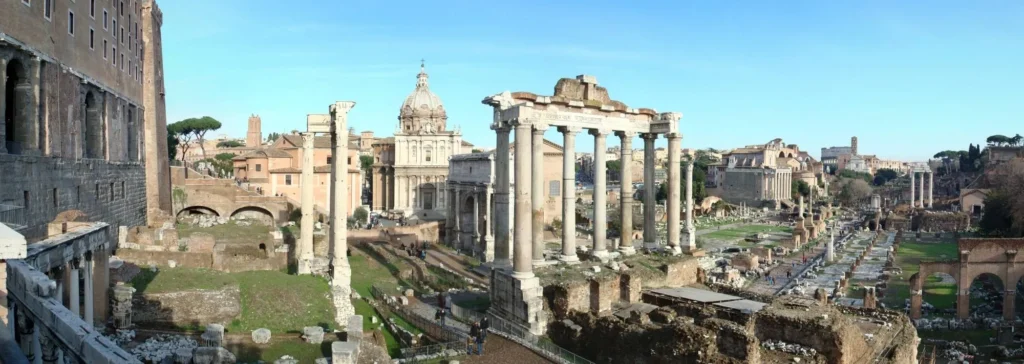
- Geological influences may be said to have acted indirectly on Early Christian architecture for the ruins of roman building often provided the quarry where obtained. This influenced the style; both as regards construction and decoration.
- Columns and other architectural features, as well as fine sculptures and mosaics from older building, were incorporated into basilican churches of the new faith.
iv) Climatic Conditions
- North Italy has the climate of the temperate region of Europe.
- Center Italy is genial and sunny.
- Southern Italy is almost tropical.
- This variety of climatic condition is sufficient to account for diversity of architectural features and treatment in the peninsula itself.
- The climatic conditions in Roman provinces as Egypt, Syria, and North Africa where Christianity was established were varied, and naturally modified the style in those countries where the fiercer sun and hotter climatic necessitated small windows and other Eastern features.
v) Religious beliefs
- According to Christianity, it must be remembered that the God preached was ” not like unto gold or silver or stone graven by art and device of man,” nor a God that dwelled ” in temples made with hands ” like those of the old Greeks and Romans which were built to shelter the statues of the gods.
- Purpose of the Christian church was to shelter worshippers who met for prayer and praise to an unseen Deity, and, during the unsettled conditions at the beginning of Christianity, various places were adapted for this worship.
- in A.D. 323 Constantine (the last emperor) himself professed Christianity, which became the official religion of the Roman Empire, and the Christians then began to build churches of a type suitable to their needs and ritual.
vi) Social Characteristics & Beliefs
- The single most important social phenomenon of the Early Christian period was the spread & acceptance of the Christian religion
- During the period from the first century to the third century after the death of Christ, Christianity was a secret society.
- Christianity was considered dangerous & subversive by the Roman government therefore they met secretly in tombs, catacombs & private houses.
- Gradually, it spread & became widely accepted in Asia minor & in Rome.
- By the third century, Rome had a population of 50,000 Christians, as a result the religion was tolerated but it was still considered illegal.
2) Architectural character
- The Early Christians, as Roman craftsmen, continued old Roman traditions.
- Utilized as far as possible the materials from Roman temples which had become useless for their original purpose for their new buildings.
- Their churches, modeled on Roman basilicas, used old columns which by various devices were brought to a uniform height.
- Early Christian buildings hardly have the architectural value of a style produced by the solution of constructive problems.
- The requirements include:
- A path for processional entry & exit of the clergy
- An alter area, where the clergy celebrate mass
- A space for the segregation of the clergy from the congregation during procession ans communion
- Burial space.
3) Building materials & construction system
i) Plans
- The Early Christians followed the basilican model for their new churches.
- May also have used old Roman halls, baths, dwelling-houses, and even pagan temples as places of worship
- An isolated circular church, used as a baptistery, was generally attached to the chief Basilica or cathedral.
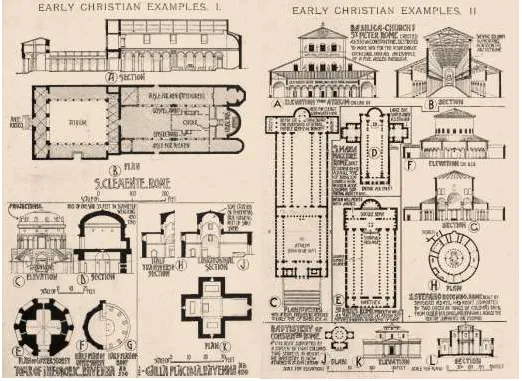
ii) Walls
- These were still constructed according to Roman methods of using rubble or concrete, faced with plaster, brick, or stone.
- Mosaic decoration was added internally, and sometimes also externally on west facades.
- Little regard was paid to external architectural effect.

iii) Openings
- Arcades, doors, and windows were spanned by a semicircular arch
- Doors, windows, and niches were generally spanned by a semicircular arch, the use of the lintel being dispensed with.
- The window openings were small those to the nave being in the clerestory high in the nave wall above the aisle roof.
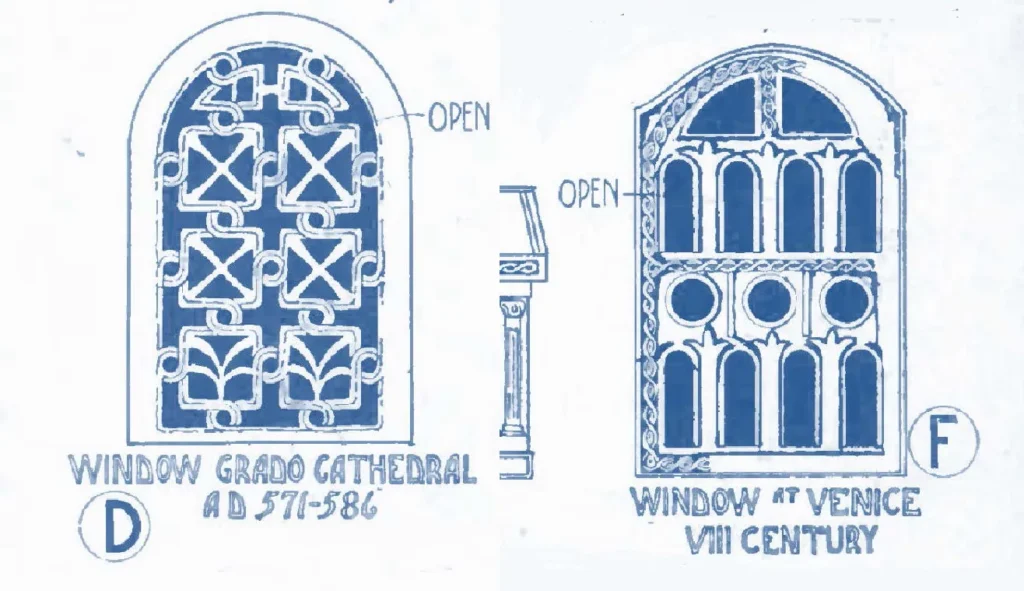
iv) Roofs
- Timber roofs covered the central nave, and only simple forms of construction, such as king and queen post trusses, were employed.
- The narrower side aisles were occasionally vaulted, and the Apse was usually domed and lined with beautiful glass mosaics, which formed a fitting background to the sanctuary.
- These roofs were ceiled in some ornamental manner, the decoration of a visible framework.

v) Columns
- Differ both in design and size, often taken from earlier Roman buildings. It was natural that early Christian builders should use materials and ornament of the pagan Romans.
- Used Tuscan, Doric, Ionic, Corinthian, or Composite from ancient Roman buildings.
- The carved capitals are in acanthus leaf forms.
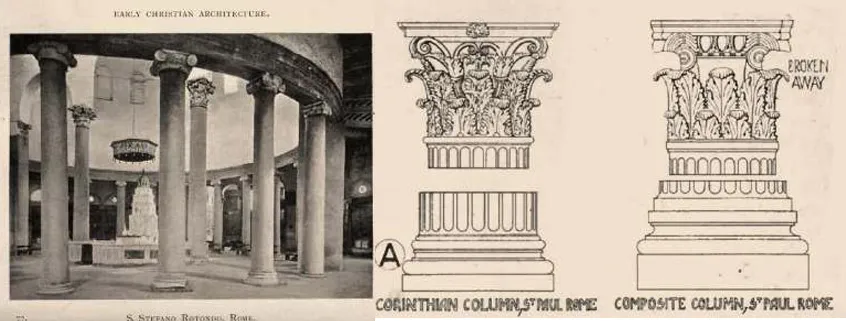
vi) Mouldings
- These are coarse variations of Roman types, and the carving is of the rudest kind, though rich in general effect.
- The technique of the craftsman gradually declined, and was at a low ebb during this period.
- Enrichments incised upon mouldings were in low relief, and the acanthus ornamentation, although still copied from the antique, became more conventional in form.

vii) Floors
- The pavements of colored marbles in geometric patterns added much to the rich effect of the interiors.
- These pavements were formed largely of slices from the old Roman porphyry columns, which were worked into designs by connecting bands of geometrical inlay on a field of white marble.

viii) Ornamentation
- The introduction of color gave richness and glimmering mystery to interiors.
- The mosaics which were the principal form of interior ornament, lined the domed apses generally represented Christ surrounded by apostles and saints with all those symbolic emblems. Usually made of glass
- The figures are treated in strong colors on a gold background.
- The design is bold and simple.
- The method of execution is coarse and large, and no attempt was made at neatness of joint or regularity of bedding.
- The interiors are, by the aid of these mosaics, rendered exceedingly impressive.
- Fresco painting usually in figure forms

4) Characteristics of early Christian church building
Early Christian Architecture is Transitional Architecture and have no own structure
The church building as we know it grew out of a number of features of the Ancient Roman period:
- The house church
- The atrium
- The basilica
- The bema
- The mausoleum: centrally-planned building
- The cruciform ground plan: Latin or Greek cross
i) House church
- The first house church is where the disciples of Jesus met together in the “Upper Room” of a house. For the first three centuries of the church, known as Early Christianity, Christians typically met in homes, if only because intermittent persecution (before the Edict of Milan in 313) did not allow the erection of public church buildings.
- Clement of Alexandria, an early church father, wrote of worshipping in a house.
- The Dura-Europos church was found to be used as a Christian meeting place in AD 232, with one small room serving as a baptistery.
- At many points in subsequent history, various Christian groups worshipped in homes, often due to persecution by the state church or the civil government.
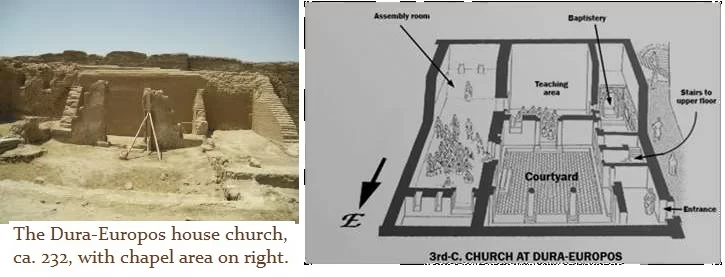
ii) Atrium
- When Early Christian communities began to build churches they drew on one particular feature of the houses that preceded them, the atrium, or courtyard with a colonnade surrounding it.
- Most of these atriums have disappeared.
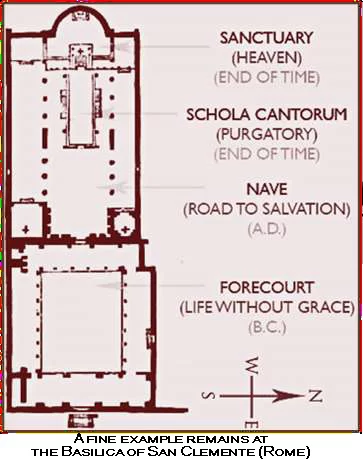
iii) Basilica
- Is a rectangular early Christian or medieval church, usually having a nave with clerestories, two or four aisles, one or more vaulted apses, and a timber roof
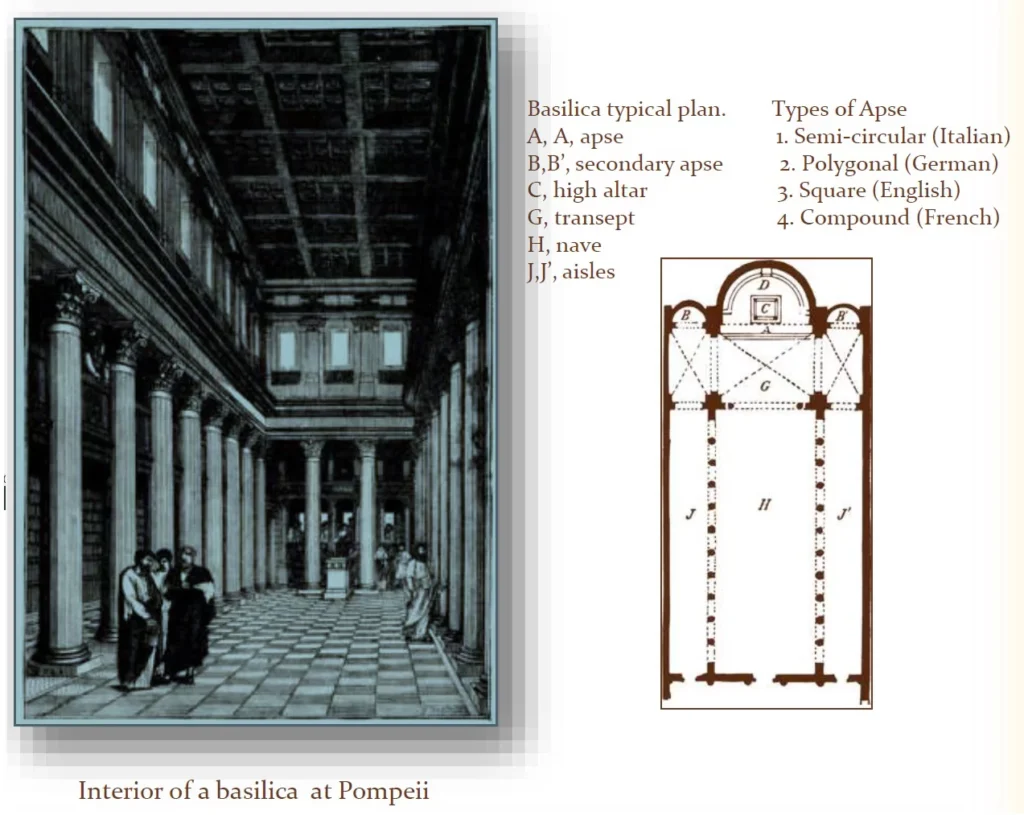
- Many basilica churches were erected out of fragments taken from older buildings, and present a curious mixture of columns, capitals, &c.; others, especially those at Ravenna, exhibit more care, and are noble specimens of ancient and severe architectural work.
- The illustration which we give of part of the nave, arcade, and apse of one of these, Sant’ Apollinare in Classe, shows the dignified yet ornate aspect of one of the most carefully executed of these buildings
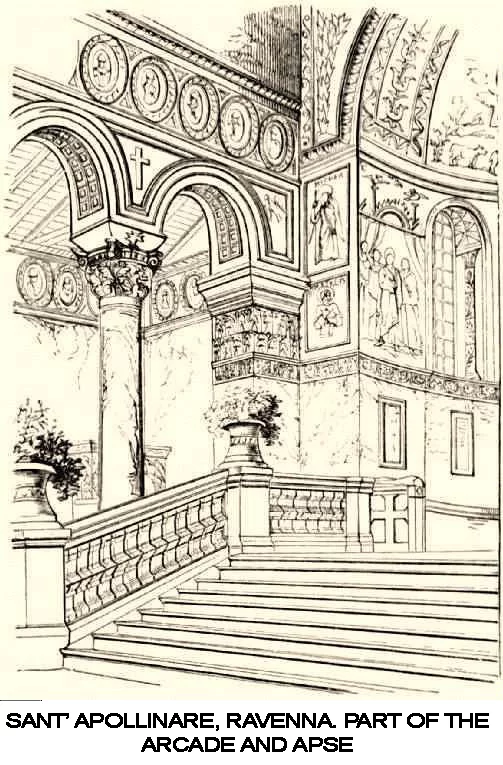
—- Parts of an Early Christian Basilica —-
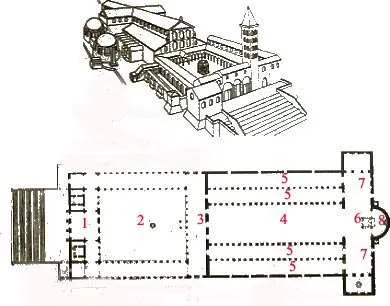
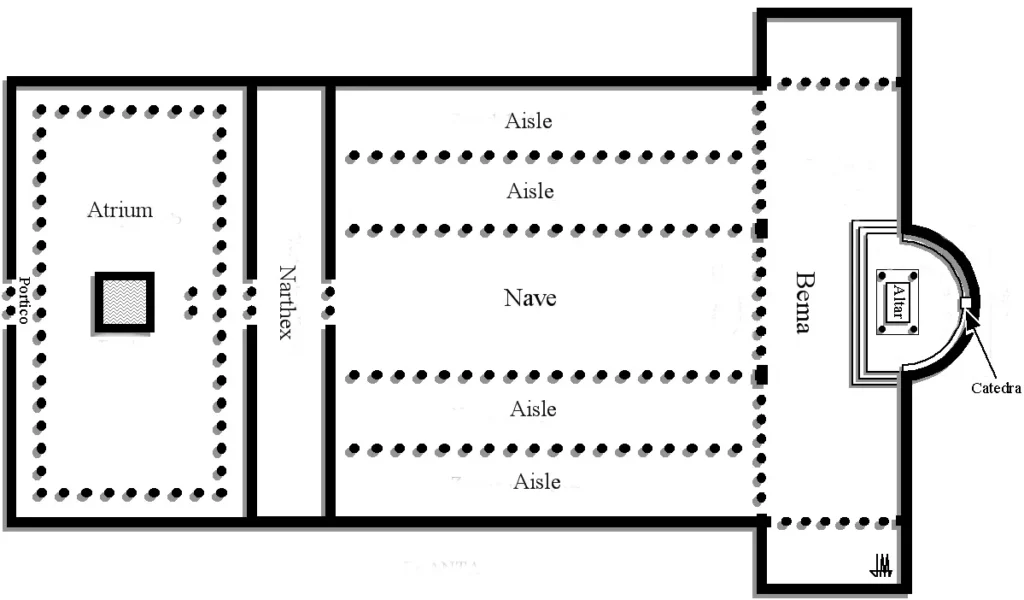
- Propylaeum- the entrance building of a sacred precinct, whether church or imperial palace.
- Atrium- in early Christian, Byzantine, and medieval architecture, the forecourt of a church; as a rule enveloped by four colonnaded porticoes.
- Narthex- the entrance hall or porch proceding the nave of a church.
- Nave- the great central space in a church. In longitudinal churches, it extends from the entrance to the apse (or only to the crossing if the church has one) and is usually flanked by side aisles.
- Side Aisle- one of the corridors running parallel to the nave of a church and separated from it by an arcade or colonnade.
- Crossing- the area in a church where the transept and the nave intersect.
- Transept- in a cruciform church, the whole arm set at right angles to the nave. Note that the transept appears infrequently in Early Christian churches. Old St. Peter’s is one of the few examples of a basilica with a transept from this period. The transept would not become a standard component of the Christian church until the Carolingian period.
- Apse- a recess, sometimes rectangular but usually semicircular, in the wall at the end of a Roman basilica or Christian church. The apse in the Roman basilica frequently contained an image of the emperor and was where the magistrate dispensed laws. In the Early Christian basilica, the apses contained the “cathedra” or throne of the bishop and the altar.
iv) The bema
- A bema was an elevated platform used as an orator’s podium in ancient Athens.
- The term can refer to the raised area in a sanctuary. In Jewish synagogues, where it is used for Torah reading during services, the term used is bima or bimah.
v) Mausoleum
- Monumental form of tomb.
- A mouseleum is a house of the dead, although ii is often as much a symbol as a sepulchre.
- This term has been employed for large, monumental, and stately tombs, usually erected for distinguished or prominent individuals.
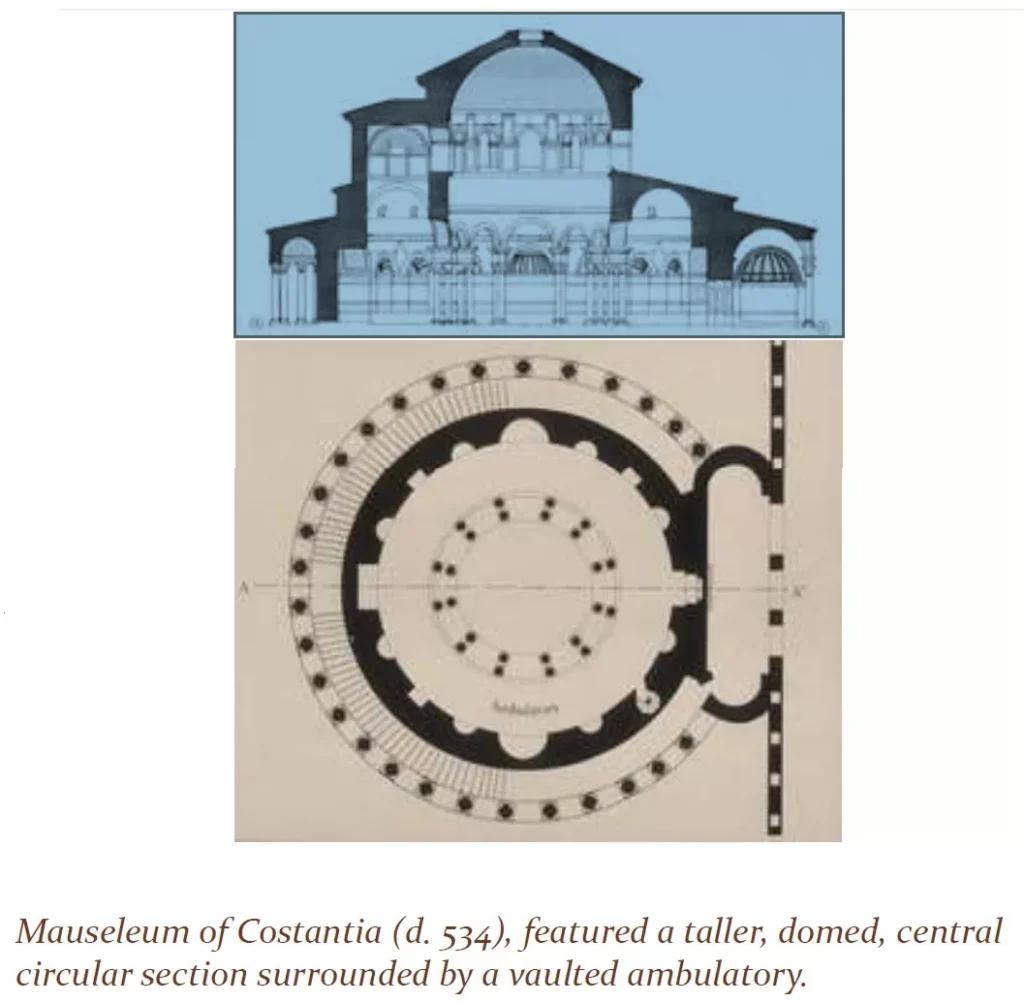
vi) Latin cross and Greek cross
- Greek cross; Latin cross; rotunda These terms usually refer to the shape of a church.
- A Greek cross church has four arms having the same length.
- A Latin cross church has the arm of the entrance longer than the other arms.

5) Examples of byzantine building
i) Rotunda church
- A rotunda (from Latin rotundus) is any building with a circular ground plan, often covered by a dome. It can also refer to a round room within a building (a famous example being within the United States capitol in Washington, D.C.). The pantheon in rome is a famous rotunda.
- The Rotunda can be found mainly not on the Roman territories, but Central Europe.
- Generally its size was 6-9 meters inner diameter and the apses was directed toward east.
- Sometimes 3 or 4 apses was glued to the central circle and this type has relatives even in the Caucasus.

ii) Catacombs
- Catacombs are ancient, human-made subterranean passageways for burial or protection.
- Any chamber used as a burial place can be described as a catacomb, although the word is most commonly associated with the roman empire. many are under cities and have been popularized by stories of their use as war refuges, smugglers’ hideouts, or meeting places for cults.

- Christians objected to cremation, insisted on burial on consecrated ground
- Land for burials had become scarce and expensive
- Monumental tombs became expressions of faith in immortality
- Cemeteries or catacombs were excavated below ground
- Several stories extending downwards
- Usually domed and enriched with lavish mosaic decorations
- Walls and ceilings were lavishly decorated with paintings mixing pagan symbolism with scenes from the bible
iv) Basilican churches
- The Latin word basilica, was originally used to describe a Roman public building (as in Greece, mainly a tribunal), usually located in the forum of a Roman town.
- In Hellenistic cities, public basilicas appeared in the 2nd century BC.
- After the Roman Empire became officially Christian, the term came by extension to refer to a large and important church that has been given special ceremonial rites by the Pope.
- The Roman basilica was a large roofed hall erected for transacting business and disposing of legal matters.
- Such buildings usually contained interior colonnades that divided the space, giving aisles or arcaded spaces at one or both sides, with an apse at one end (or less often at each end), where the magistrates sat, often on a slightly raised dais.
- The central aisle tended to be wide and was higher than the flanking aisles, so that light could penetrate through the clerestory windows.
- It is a long rectangle two stories high, with ranks of arch-headed windows one above the other, without aisles (no mercantile exchange in this imperial basilica) and at the far end, beyond a huge arch, the apse in which Constantine held state.
- Basilicas of this type were built not only in Western Europe but in Greece, Syria, Egypt, and Palestine.
- Examples of the architectural basilica:
- the Church of the Nativity at Bethlehem (6th century),
- the church of St Elias at Thessalonica (5th century), and
- the two great basilicas at Ravenna.
St. Peter’s, Rome
- Erected by Constantine near the site of St. Peter’s martyrdom
- The Circus of Nero was torn down to erect it

5) Other examples:
a) Basilican churches
S. Apollinare, Ravenna
S. Sabina
S. Agnese Fuori Le Mura, Rome
St. Paulo Fuori Le Mura
S. Clemente, Rome
S. Maria Maggiore, Rome
b) Baptisteries
- Used only for sacrament of baptism, on festivals of Easter, Pentecost and Epiphany
- Large separate building from church, sometimes adjoined atrium
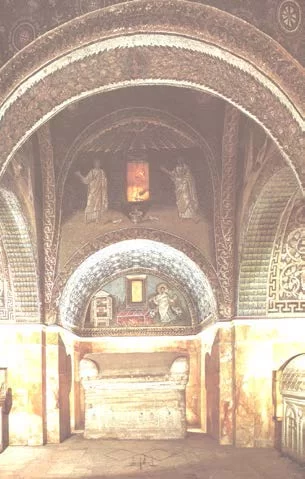
c) Tombs or catacombs
- Christians objected to cremation, insisted on burial on consecrated ground
- Land for burials had become scarce and expensive
- Monumental tombs became expressions of faith in immortality
- Cemeteries or catacombs were excavated below ground
- Several stories extending downwards
- Usually domed and enriched with lavish mosaic decorations
- Walls and ceilings were lavishly decorated with paintings mixing pagan symbolism with scenes from the bible
Overall, early Christian architecture was characterized by its simplicity and functionalism, with an emphasis on creating spaces for worship and reflection. Despite its humble origins, it went on to greatly influence the development of later Christian architectural styles, including Romanesque and Gothic architecture.
Information is relevant